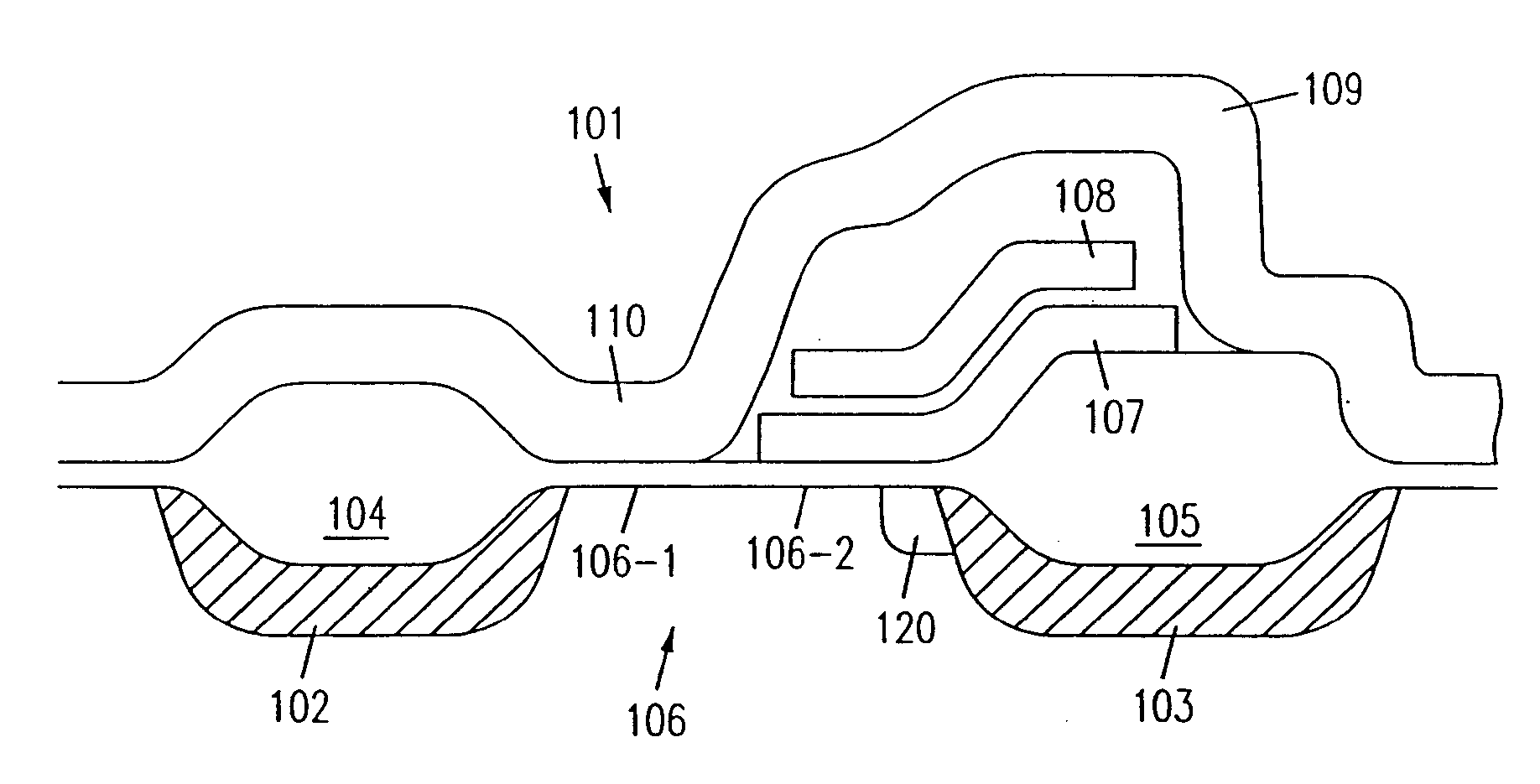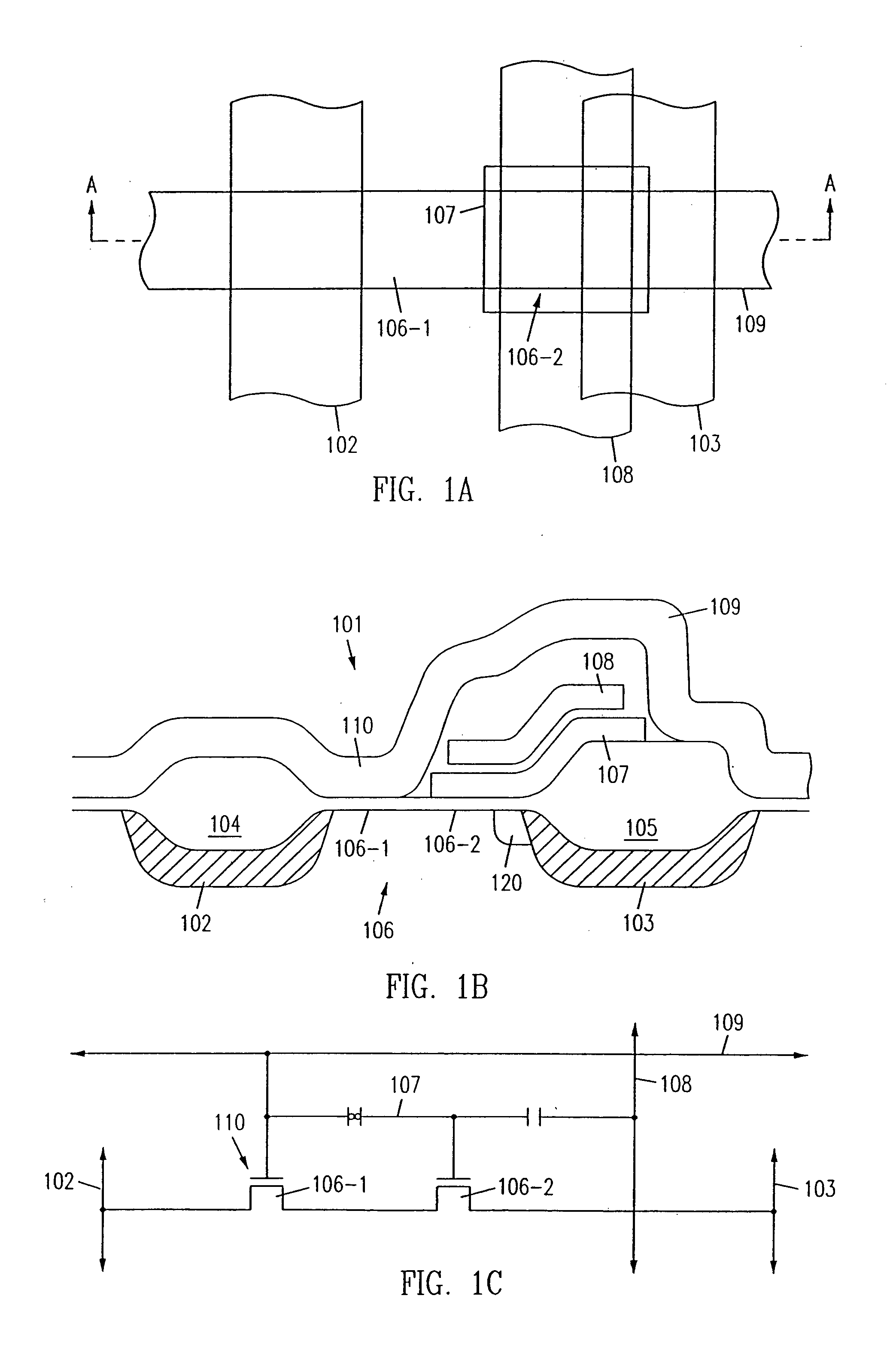Eeprom with split gate source side injection
a technology of source side injection and eeprom, which is applied in the direction of transistors, solid-state devices, instruments, etc., can solve the problems of difficult to pit the substrate without pitting, severe junction leakage as well as loss of a portion of the bn+ conductor, and additional process complexity of forming the thin oxide region and extra space needed to place this thin oxide region
- Summary
- Abstract
- Description
- Claims
- Application Information
AI Technical Summary
Benefits of technology
Problems solved by technology
Method used
Image
Examples
first embodiment
[0098] A second array embodiment is similar to that of FIG. 1d but uses the cell embodiment shown in FIG. 1b, to form a row oriented sector architecture, is shown in FIG. 1g. A sector consists of a group of rows, four in this example, which are erased together. Erase uses option 2 of Table 1, for this row oriented sector architecture, bringing all the poly 3 word lines of a sector to high voltage. The poly 2 steering gate is common to a group of N sectors where N can range from 1 to the full size of the memory array. Similarly the BN+ columns can alternatively continuously span the full length of the array or be broken down into a collection of shorter length, local columns. These connect to a global (full array length) column through a select transistor driven by an additional level of decoding. The local columns can range from 1 to N sectors. The preferred embodiment is to have local columns span the same number of sectors as the poly 2 steering gate. A preferred number of sectors...
second embodiment
[0108] FIG. 5 is a two-poly embodiment in which programming occurs by taking drain 303 high, for example about 10V while raising control gate 308 just sufficiently so as to turn on select transistor 310. Since this V.sub.CG voltage can vary from one device to another it is possible to achieve the optimum injection conditions by keeping V.sub.CG at about 3V while raising source (virtual ground) 302 in a sawtooth fashion from about 0 to 3 volts and back to 0 again, with a period on the order approximately 1 microsecond.
[0109] This ensures that at some point along the sawtooth the optimum injection conditions are met. Reference can also be made to European Patent Application Serial No. 89312799.3 filed Aug. 12, 1989. To further enhance programming efficiency, in one embodiment a programming efficiency implant 330 (shown in dotted line) is introduced at the source side. To read the device, its source is 0V, drain is approximately 1.0 v and V.sub.CG approximately 4.5-5 v. To erase we emp...
third embodiment
[0118] FIG. 6 is a cross-sectional view of alternative embodiment of a two poly cell, using source side injection for programming, aided by strong coupling to buried N+ drain 403, which acts also as a second control gate. Erase is by Fowler-Nordheim tunneling to channel 406 through a small thinned oxide region, formed for example to a thickness of about 100 .ANG., by utilizing a thin polyspacer. These process steps would be as follows: Once the drain oxide is formed (i.e. the oxide above drain 403), a first layer of poly, (approximately 2000 .ANG. to 4000 .ANG. thick) is deposited and a thin nitride dielectric is deposited on top. These layers are then etched using a poly 1 mask to delineate the lateral extent (as shown in FIG. 6) of the poly 1. A second layer of nitride is then deposited and anistropically etched back to underlying oxide, leaving the initial nitride layer on top of poly 1 plus nitride spacers along the poly 1 sidewalls. This protects the poly 1 sidewall from subseq...
PUM
 Login to View More
Login to View More Abstract
Description
Claims
Application Information
 Login to View More
Login to View More - R&D
- Intellectual Property
- Life Sciences
- Materials
- Tech Scout
- Unparalleled Data Quality
- Higher Quality Content
- 60% Fewer Hallucinations
Browse by: Latest US Patents, China's latest patents, Technical Efficacy Thesaurus, Application Domain, Technology Topic, Popular Technical Reports.
© 2025 PatSnap. All rights reserved.Legal|Privacy policy|Modern Slavery Act Transparency Statement|Sitemap|About US| Contact US: help@patsnap.com



